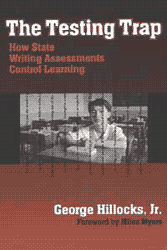
. . . should we expect tests, in and of themselves, to bring about higher achievement in schools? Do we believe testing will bring about changes in what happens in classrooms, change that will in turn bring about different and perhaps higher levels of student achievement? Do we believe that simply the threat of sanctions will encourage students and teachers to work harder? Why should we believe that? (p. 12)The first sixteen pages of this text offer a montage of what happens when political imperatives collide with constructionist notions of learning. The aftermath is not only a compromise of test content, but also a sort of educational McDonalization (Hayes and Wynyard, 2002). One thing that means is that extended essay writing which is not rapidly tested gets sidelined.
| "Most writing tests, in Hillocks' view, amount to little more than superficial pre-writing exercises, since examinees are not given enough time to critically develop their essays." |
[ p. 12 ]
Part of the problem in this country is that systematic thinking about difficult problems seems to be confined to an elite group. Most Americans are not willing to think much beyond their own desires and perspectives, which often determines what they think is right and appropriate. Perhaps most people cannot think carefully about complex problems. (pp. 6,7)Would these same comments apply to Japan's educational system? If Baker and LeTendre (2000, p. 356) are correct, the situation is by no means exclusive to the USA.
Contemporary educational theory and practice argue that effective learning must be constructivist in nature, and that students learn best and perhaps only when they can construct knowledge for themselves within the framework of their existing knowledge. (p. 22)This type of argument presupposes that there is only one sort of learning. However theorists such as Bloom (1956) and Gardner (1983) suggest that there are in fact multiple types of learning. Rote learning might be appropriate for certain tasks, but certainly not for the full scope of education.
[ p. 13 ]
| "the Kentucky writing portfolio assessment system . . . is one of the few writing tests . . . that strives for some semblance of a real audience and a broader writing purpose." |
[ p. 14 ]
At the center of the K-12 testing fury is the myth that testing alone is able to raise standards and the rate of learning. Certainly, testing assures what is tested is taught, but tests cannot assure that things are taught well. If states want teaching to improve they will have to intervene at the level of teaching. Teachers need opportunities to learn more effective procedures for teaching writing. Tests of writing cannot teach that. (p. 204)
| "Writing is a skill which defies superficial, facile assessment: the communication of deep ideas is hard to translate readily into numerical variables." |
[ p. 15 ]
A third issue concerns test washback in general. Perhaps too simplistically, Hillocks views state-mandated exams as significantly determining teacher behavior. Cheng (2004, p. 148) suggests washback is a more complex phenomena and Stoll (cited in Haney, 2000) adds, "It's immensely hard to get a critical mass of teachers within a school, let alone a district, to significantly change their practice." Even as new laws and new tests are enacted, teachers are often remarkably inure to change.
- Reviewed by Tim Newfields
Toyo University
| Categorical Index |
Chronological Index |
Subject Index |
Title Index |